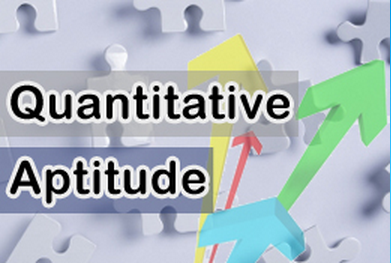Hello Aspirants. Welcome to Online Quantitative Aptitude section in AffairsCloud.com. Here we are creating question sample From all topics , which are Important for upcoming IBPS exams. We have included Some questions that are repeatedly asked in exams.
1 – 5: As per the budget for the year 2007-08, proposals for personal income tax are: From the total salary income, 1/3rd of the income or Rs.25,000, whichever is lower, may be deducted. From the dividend income, the total of dividend income or Rs.20,000, whichever is lower, may be deducted. Up to Rs.1,00,000, the investment is free from the tax, it is also assumed that investment has been done from your own income. The balance after these deductions is taxable income. The first Rs.1,10,000 is tax free. Up to Rs.1,50,000, the tax is 10% of the income above Rs.1,10,000. Above Rs.1,50,000 to Rs.2,50,000, it is 20% of the income above 1,50,000. Above Rs.2,50,000, it is 30% of the income above Rs.2,50,000. From the tax so calculated, 1/5th of the tax or subject to maximum of Rs.10,000, may be deducted as rebate. For an individual above the age of 65 years, 1/5th of the tax or subject to maximum of Rs.15,000 may be deducted as rebate from the tax so calculated.
- If a 45 year-old person has a salary income of Rs.3,50,000, dividend income of Rs.75,000 and has made an investment of Rs.40,000, then what is the amount due on him as income tax for the financial year 2007-2008?
(a) 41,000
(b) 38,500
(c) 33,000
(d) 19,000(a) 41,000
- If a 35-year-old person has a salary income of Rs.2,75,000, and has received no dividend income, then what could be the minimum amount of tax due on him for the financial year 2007-2008?
(a) 24,000
(b) 29,000
(c) 12,000
(d) 3,200(d) 3,200
- For the financial year 2007-2008, what could be the maximum income for a 40-year-old person who has no dividend income, has made the maximum tax-free investment and his total income tax for the financial year is zero?
(a) 2,10,000
(b) 2,35,000
(c) 2,55,000
(d) 2,40,000(b) 2,35,000 - For the financial year 2007-2008, what could be the minimum income of a 70-year-old man who has no dividend income, has made the maximum tax-free investment and enjoys a rebate?
(a) 3,75,000
(b) 3,80,000
(c) 3,85,000
(d) None of these(d) None of these - If a 67-year old person has a salary income of Rs.1,45,000, and has received no dividend income, then what is the minimum amount of tax due on him for the financial year 2007-2008 if he has made an investment of Rs.20,000?
(a) 100
(b) 1,000
(c) 500
(d) None of these(d) None of these
- The radius of a sphere is 14 cm. The cost of painting the surface of sphere is Rs 25 per square cm. If the radius of sphere is increased by 10%, then the cost of painting is increased by 20%. What is the percentage increase in the total cost of painting per square cm?
A. 45.2%
B. 54.27%
C. 20.3%
D. 18.2%A. 45.2%
Explanation:
Radius increases by 10%, so surface area changes by 10+10+((10*10)/100) = 21%
Total cost of painting = Rate * Surface area of sphere
So change in cost of painting = 21+20+((21*20)/100) = 45.2% - Out of 7 consonants and 4 vowels, how many words of 3 consonants and 2 vowels can be formed?
A. 25200
B. 1050
C. 210
D. None of theseA. 25200
Explanation:
7C3 * 4C2 * 5! - The incomes of A and B are in the ratio 3 : 2 and their expenditures are in the ratio 5 : 3. If each saves Rs 2000, what is A’s income?
A. Rs 15,000
B. Rs 12,000
C. Rs 14,000
D. None of theseB. Rs 12,000
Explanation:
Let incomes be 3x and 2x. Expenditures be 5y and 3y.
3x – 5y = 2000
2x – 3y = 2000
Solve the equations, x = 4000
So A’s income = 3x = 3*4000 = 12,000 - By selling an item at 7/10th of the actual selling price, a trader makes a profit of 20%. If he sells the product at 20% less than the actual selling price, then what will be the profit or loss %?
A. 30%
B. 20%
C. 37 1/7%
D. 33 1/3%C. 37 1/7%
Explanation:
C.P. S.P.
Profit is 20%. So,
(7/10 S.P. – C.P.)/C.P. * 100 = 20
This gives S.P. = 12/7 C.P.
Now product sold at 20% less S.P. i.e. 80/100 or 4/5 of S.P.
Profit/loss% = (4/5 S.P. – C.P.)/C.P. * 100
Put S.P. = 12/7 C.P. and find the final answer - A man can row 30 km upstream and 44 km downstream in 10 hrs. Also, he can row 40 km upstream and 55 km downstream in 13 hrs. Find the speed of the man in still water.
A. 5 km/hr
B. 8 km/hr
C. 10 km/hr
D. 12 km/hrB. 8 km/hr
Explanation:
Let upstream speed = x, downstream speed = y km/hr
Then, 30/x + 44/y = 10 and 40/x + 55/y = 13
Put 1/x = a, 1/y = b
Solve the equations.
A = 1/5, b = 1/11
So, x = 5, y = 11
Speed in still water = (5+11)/2 = 8



